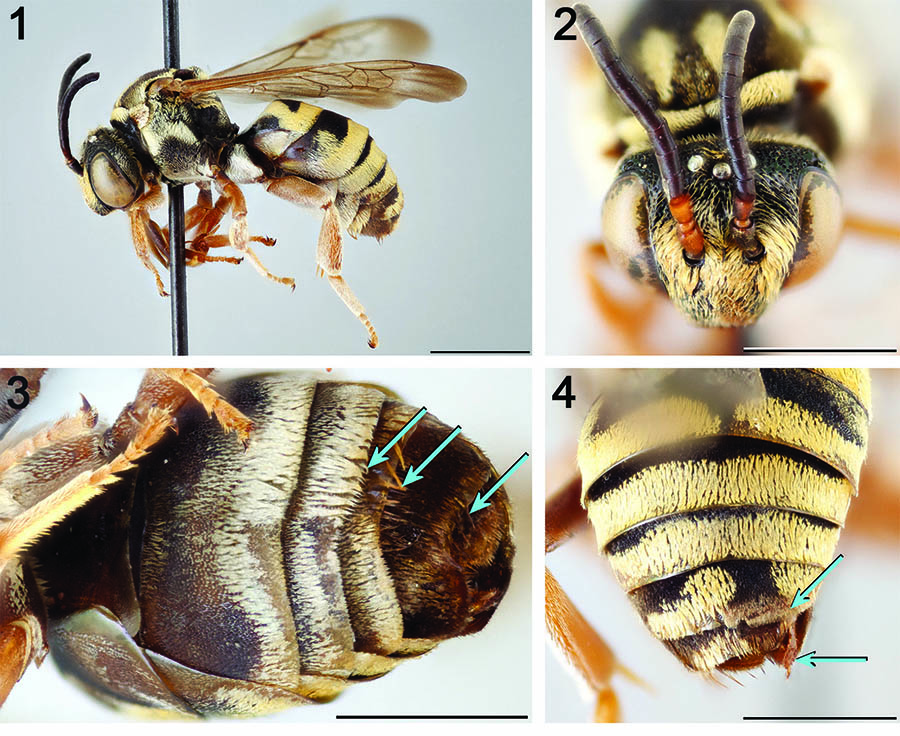A record of bilateral gynandromorphism in Epeolus (Hymenoptera: Apidae: Nomadinae)
DOI:
https://doi.org/10.17161/jom.v0i76.7056Keywords:
Apidae, Bilateral gynandromorphism, Epeolus flavofasciatus, Gynander, NomadinaeAbstract
The discovery of a gynandromorph of a North American Epeolus Latreille is reported. A specimen of E. flavofasciatus Smith from Flagstaff, Arizona, USA discovered in the collection of the American Museum of Natural History (AMNH) exhibits male-specific features on the left and female-specific features on the right, consistent with bilateral gynandromorphism (the first known case in the genus). Descriptions and images of the aberrant features exhibited by the specimen are presented.References
Engel, M.S. 2007. Lateral gynandromorph in the bee genus Thyreus and the sting mechanism in the Melectini (Hymenoptera: Apidae). American Museum Novitates 3553: 1–11.
Hinojosa-Díaz, I.A., V.H. Gonzalez, R. Ayala, J. Mérida, P. Sagot, & M.S. Engel. 2012. New orchid and leaf-cutter bee gynandromorphs, with an updated review (Hymenoptera, Apoidea). Zoosystematics and Evolution 88(2): 205–214.
Lucia, M., & V.H. Gonzalez. 2013. A new gynandromorph of Xylocopa frontalis with a review of gynandromorphism in Xylocopa (Hymenoptera: Apidae: Xylocopini). Annals of the Entomological Society of America 106(6): 853–856.
Michez, D., P. Rasmont, M. Terzo, & N.J. Vereecken. 2009. A synthesis of gynandromorphy among wild bees (Hymenoptera: Apoidea), with an annotated description of several new cases. Annales de la Société Entomologique de France 45(3): 365–375.
Onuferko, T.M. 2017. Cleptoparasitic Bees of the Genus Epeolus Latreille (Hymenoptera: Apidae) in Canada. Canadian Journal of Arthropod Identification 30: 1–62.
Onuferko, T.M. In press. A revision of the cleptoparasitic bee genus Epeolus Latreille for Nearctic species, north of Mexico (Hymenoptera, Apidae). ZooKeys
Pérez-Iñigo Mora, C. 1982. Sobre dos interesantes casos teratológicos en Apoideos (Hym. Apoidea). Boletin de la Asociacion Espanola de Entomologia 6(1): 29–31.
Rightmyer, M.G. 2008. A review of the cleptoparasitic bee genus Triepeolus (Hymenoptera: Apidae). Part I. Zootaxa 1710: 1–170.
Schenk, U. 1871. Einige Bienen-Hermaphroditen. Entomologische Zeitung 32(10-12): 335.
Torchio, P.F. & D.J. Burdick. 1988. Comparative notes on the biology and development of Epeolus compactus Cresson, a cleptoparasite of Colletes kincaidii Cockerell (Hymenoptera: Anthophoridae, Colletidae). Annals of the Entomological Society of America 81(4): 626–636.
Tsuneki, K. 1975. A partial gynandromorph appeared in the cuckoo bee Nomada sp. (Hymenoptera, Apidae). Kontyû 43: 173–180.
Wcislo, W.T., V.H. Gonzalez, & L. Arneson. 2004. A review of deviant phenotypes in bees in relation to brood parasitism, and a gynandromorph of Megalopta genalis (Hymenoptera: Halictidae). Journal of Natural History 38(11): 1443–1457.
Wolf, H. 2000. Ein Zwitter von Epeolus julliani Pérez 1884 (Hymenoptera, Apidae). Linzer biologische Beiträge 32(2): 1321–1322.
Downloads
Published
Issue
Section
License
Copyright for articles published in Journal of Melittology is retained by the authors, with first publication rights granted to the journal. By virtue of their appearance in this open access journal, articles are free to use, with proper attribution and permission of the authors, in educational and other non-commercial settings.





